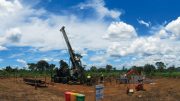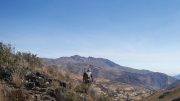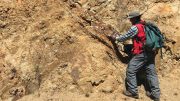Earlier this year, Filo Mining (TSXV: FIL; US-OTC: FLMMF) unveiled a prefeasibility study (PFS) for its Filo del Sol copper-gold-silver project, 140 km southeast of Copiapo, Chile, on the border between Chile and Argentina.
The study assigns the project a US$1.3-billion, after-tax net present value at an 8% discount rate and a 23% after-tax internal rate of return. It uses metal prices of US$3 per lb. copper, US$1,300 per oz. gold and US$20 per oz. silver.
The project would produce on average 67,000 tonnes copper, 159,000 oz. gold and 8.65 million oz. silver per year over a 14-year mine life at US$1.23 per lb. copper equivalent cash costs, and achieve payback in 3.4 years. It would require US$1.27 billion in initial capital and US$217 million in life-of-mine sustaining capital.
The study also included a maiden reserve estimate for the project. Filo del Sol contains 259.1 million probable tonnes grading 0.39% copper, 0.33 gram gold per tonne and 15.1 grams silver per tonne for 2.2 billion lb. copper, 2.76 million oz. gold and 126 million oz. silver.
Split between oxides and sulphides, the project contains a total 425.1 million indicated tonnes grading 0.33% copper, 0.32 gram gold and 10.7 grams silver for 3.1 billion lb. copper, 4.4 million oz. gold and 146.8 million oz. silver, as well as 175.1 million inferred tonnes at 0.27% copper, 0.33 gram gold and 6.2 grams silver for 1.05 billion lb. copper, 1.8 million oz. gold and 34.7 million oz. silver. The resource is based on 44,600 metres of drilling in 158 reverse-circulation holes, and 30 core holes.
In oxides alone, the project has 349.6 million indicated tonnes grading 0.34% copper, 0.32 gram gold and 12.6 grams silver for 2.65 billion lb. copper, 3.6 million oz. gold and 141.3 million oz. silver, as well as 103.9 million inferred tonnes at 0.26% copper, 0.32 gram gold and 8.7 grams silver, for 585 million lb. copper, 1.08 million oz. gold and 29 million oz. silver.
The reserve estimate only includes the oxide part of the current mineral resource, as Filo has yet to test if its sulphides are leachable. All of its leachable oxides, however, made it into the project’s reserves.
“We’ll do a program this year to test some of what we’re calling the ‘sulphide transitional zone’ to see if any of that material’s leachable,” Filo president and CEO Adam Lundin says in an interview with The Northern Miner. “If material from this ‘transitional zone’ is leachable, it will be quite easy to update the PFS to incorporate that.”

Drillers at Filo Mining’s Filo del Sol copper-gold project in the Atacama region of Chile and Argentina. Credit: Filo Mining.
The company recently completed a seven-hole drill program at Filo to evaluate the sulphide mineralization sitting below the oxide mineralization in the current deposit. The holes potentially indicate a large copper-gold porphyry lies underneath the current resource.
“Our hope is to prove the concept that there’s a copper porphyry system at depth,” Lundin says. “We have an oxide cap, and we thought ‘What put that mineralization there? It’s probably a porphyry at depth, but how deep is that porphyry, and is it directly under our d–eposit?’
“We came up with the view after the team did a bunch of work that the deposit is telescoped, and we viewed the porphyry as probably sitting right underneath the oxide cap.”
The company hopes to have proved this theory with its first two holes, drilled 500 metres apart. The first hole cut 0.3% copper, 0.22 gram gold and 1.6 grams silver over 1,025 metres from surface, and the second hole cut 0.39% copper, 0.34 gram gold and 1.6 grams silver over 614 metres from surface. Both holes ended in mineralization. The deposit remains open both at depth and laterally.
The company is waiting for assays for the five remaining holes, and expects to get them before May 2019. Filo drilled the holes to depths of 600 metres, and spaced them an average 500 metres apart.
“That was uncharted waters for us,” Lundin says. “Those were new rocks we were going into, and so to be able to have that success was very exciting for us. Next season I think we’ve already seen enough where we want to do a follow-up program, and try to vector down on the results we’re going to have.”
The company will also continue its baseline studies this year, and drilling to define a water resource in Argentina. Lundin says the company can pull groundwater in Argentina, “which is a big benefit to having the majority of the project sit in Argentina.”
Filo is part of a binational treaty between Argentina and Chile allowing the company’s workforce to move freely across the border. The company will have to code its block model, so ore it pulls from Chile and Argentina is taxed under each country’s respective tax code, and it will have to permit the project in both countries.
Shares of Filo Mining are trading at $2.65 in a 52-week range of $2 to $2.70. The company has a $193-million market capitalization.
Filo ended 2018 with $2.4 million in cash. It obtained two unsecured US$5-million credit facilities in early 2019. It has explored less than 20% of its Filo del Sol land package to date.






Be the first to comment on "Filo tables study for flagship project on Chilean-Argentine border"